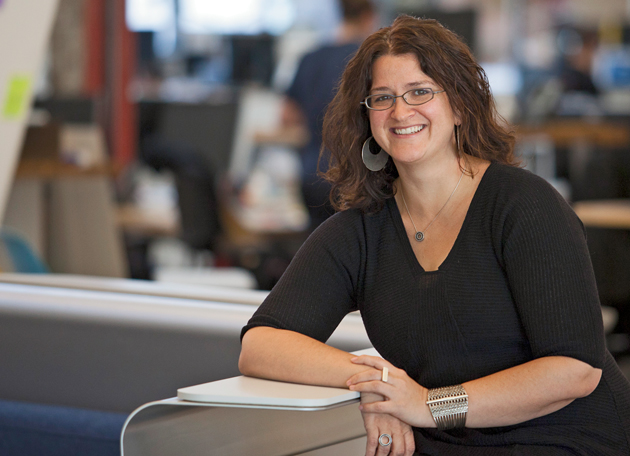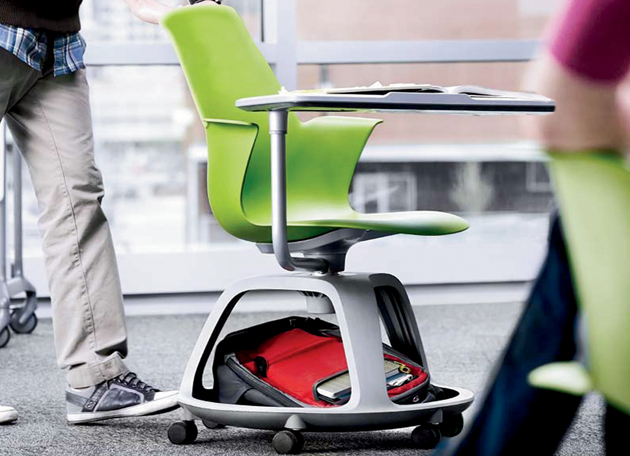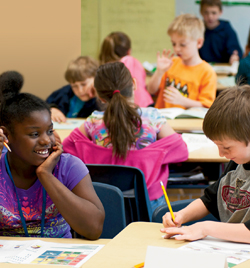
Imagine a chair in a classroom.
If you’re a grown-up of a certain age, you’ll probably envision a chair that’s attached to a desktop and bolted to the floor. It’s hard and uncomfortable — a one-size-fits-all chair designed for the kind of classroom where students are expected to sit quietly and raise their hands before speaking.
Enter Sandy Speicher, BFA ’96, who leads IDEO’s innovative Design for Learning domain. When IDEO was invited by the furniture manufacturer Steelcase to redesign the classroom chair to fit the needs of today’s classroom, they had to shed their preconceived notions of what a chair is and figure out what it could become.
In recent years, the entire educational system itself has been changing to try to meet the needs of today’s learners. Therefore, the objects in the classroom must be adapted to meet the demands of a very different student experience.
“We all have this image in our brains of what a classroom chair looks like,” Speicher says. “Of course, it achieves certain functions: You have a place to sit. But it also tells you not to move because the design makes it very difficult to do that.”
But times are changing. In recent years, the entire educational system itself has been changing to try to meet the needs of today’s learners. Therefore, the objects in the classroom must be adapted to meet the demands of a very different student experience.
IDEO, collaborating with Steelcase, designed a chair with wheels so that it could be moved around. The chair has a roomy base under the seat for student book bags. As you move, your bag comes with you. The chair also swivels so you can see what’s going on anywhere in the room. It has a larger desk surface so that you can fit a laptop computer on it. Or, the desk surface can move out of the way entirely.
“You can configure it different ways,” Speicher notes, “but what it says is, ‘Go ahead; move around. Do what you need to do.’” Students and teachers both are asking for a more dynamic learning environment.
Schools today are charged with a different task than those of 100 or even 50 years ago. Back then, the United States sustained an industrial economy and needed its schools to prepare young people for the routines of factory work. Workplaces today, though, need people who can innovate, and this requires a very different way of learning. The new, information-based economy needs schools to prepare young people who can be engaged, adapt and think creatively and collaboratively to solve problems.
Think about others
Several years ago, before she joined IDEO, Speicher taught design to fifth-graders in a public school in San Francisco. A favorite assignment was to randomly pair the students, and ask them to interview and then carefully observe one another. Each student was to imagine five or six ideas that could improve their partner’s life — either now or in the future.
“One of the students noticed his partner Paul really cared about how his hair looked,” Speicher recalls. “So, he designed a hairspray can for Paul that had a built-in blow dryer. This way Paul could fix his hair just how he liked it, spray it, and then use the blow dryer to quickly set it in place.
“It is always amazing to see kids light up through design,” Speicher adds. “What we were really asking them to do was start to think about others — how they can combine the needs and interests of others with their own unique view of what is possible — and design something that makes a difference in that other person’s life.”
Make the world better
Speicher traces her current career trajectory to a transformative classroom experience she had teaching graphic design to undergraduates at Washington University.
It was about 10 years ago — the day after President George W. Bush had declared war on Iraq. Speicher’s students came to class as usual that day and began quietly pinning their work to the board in preparation for that day’s typography critique.
“One thing I’ve learned is that when you orient in the world as a designer, it’s your job to help shape the world around you.”
—Sandy Speicher, BFA ’96
“I said to them, ‘Why are you hanging up your work? We’re at war. Let’s talk about it,’” Speicher recalls. “They responded: ‘Can’t we just go on with our day?’”
Speicher persisted, and eventually the students opened up. She was relieved to learn that it wasn’t for a lack of interest or of empathy they didn’t want to talk about the war. It was simply they couldn’t imagine having any direct impact on world events — and they were discouraged by this realization.
“They were so aware, and they had so much information,” Speicher says. “They didn’t want people dying. Yet they were saying, ‘We get there are these complicated things going on, but we don’t know what to do about it, so we just want to go on with our day.’
“It feels as if the world is bigger than you,” Speicher acknowledges. “But one thing I’ve learned is that when you orient in the world as a designer, it’s your job to help shape the world around you. The question for me became, ‘What’s happening in our education system that we’re not preparing youth to realize they have a role in the world?’”
Speicher emphasizes that was the moment she realized what design has to offer. “Design is the way we engage in the world to make it better,” she says.
Shape the future
Subsequent to that epiphany, Speicher returned to school and earned a master’s degree in education at Stanford University, in the Learning, Design and Technology program. She started to build the education domain at IDEO in 2008 and has since helped numerous students, teachers, schools, charter organizations, districts, universities, foundations and nonprofit organizations design new systems for learning.
Though some of their IDEO projects are physical in nature, like the development of the Steelcase Node chair, Speicher and her colleagues are often engaged in addressing more systemic challenges. One of her teams, for instance, is partnering with an organization in Peru to design a school model that is of international quality, affordable and scalable. They have to design everything: the academic model, the physical spaces, the tools to support teachers, as well as the financial model that underlies it all. Other IDEO teams are designing tablet-based learning platforms for middle school students; environments that foster collaborative learning in universities and corporate centers; and approaches for systemic change, such as identifying creative ways to engage parents in national education topics.
For example, when President Obama in his 2011 State of the Union address called for 100,000 new teachers in the fields of science, technology, engineering and math, the Carnegie Corporation contacted IDEO shortly afterward to ask for help meeting the president’s challenge.
In response, IDEO designed a workshop that brought together relevant organizations across the country and asked them to consider the best ways for encouraging, accelerating, funding and guiding teacher training in the targeted areas. Those meetings resulted in the creation of a transformative organization called “100K in 10,” which so far contains more than 100 organizations that have committed to the training of 30,000 science, technology, engineering and math teachers.
“If we realize that we are in essence all designers, we can decide to redesign the way education happens, to meet the needs of today.”
—Sandy Speicher
In a separate IDEO initiative called “Design Thinking for Educators,” Speicher works with teachers of all disciplines to help them see how adopting the mind-set of the designer can be a powerful means of creating change.
“Everything around us is designed,” she says. Not just the tangible things, but systems, too, including the systems devised for learning. “If we realize that we are in essence all designers,” she continues, “we can decide to redesign the way education happens, to meet the needs of today.”
As part of the Design Thinking for Educators initiative, IDEO has published an educator’s toolkit online. The toolkit has generated more than 120,000 site visits from about 170 countries since it was launched a year and a half ago.
For some teachers who participate in the Design Thinking for Educators workshops, the little “aha” moments matter most. One teacher, for example, was astounded to realize that he had never actually asked the kids how they felt about their classroom.
When he made time to talk with them, he learned that most of his first-grade students were too short to actually see the bulletin boards he had spent hours laboring over each year. So he lowered the displays to put them at a more accessible height. He now engages the children in nearly every classroom design decision and thinks about his role as a teacher much differently.
“I love that because it is so simple and tangible, yet I understand that alone is not education reform,” Speicher says. “However, multiply that by three million teachers across the country, along with all of us applying intentional design processes to help address big challenges in education — and then you really will see education reform!”
Gretchen Lee, AB ’86, is a freelance writer based in San Francisco.


Comments and respectful dialogue are encouraged, but content will be moderated. Please, no personal attacks, obscenity or profanity, selling of commercial products, or endorsements of political candidates or positions. We reserve the right to remove any inappropriate comments. We also cannot address individual medical concerns or provide medical advice in this forum.